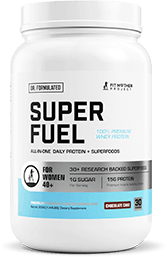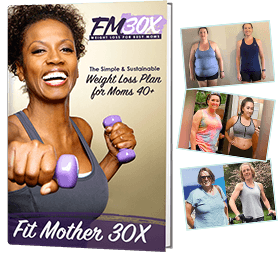A slow metabolism isn’t inevitable with age, as simple solutions can increase your body’s metabolic rate to help you shed pounds.
While metabolism does tend to decrease each decade of life, you don’t have to settle for being overweight or eating very few calories.
Simple strategies can boost a slow metabolism and help you avoid dreaded age-related weight gain and maintain the body you want!
Try the tips below to get started!
Learn how you can start increasing your metabolism after 40!
What is Metabolism?
Metabolism is your body’s ability to convert calories from food and drinks into energy. It’s a process that fuels your body and allows it to complete essential functions needed to sustain life.
The more calories your body burns daily, the higher your metabolism is.
In order to maintain your body weight, you must burn the same number of calories as you consume from food and drinks.
To effectively lose weight, you must expend more calories through activities of daily living and exercise than you eat. If you consume more calories than you burn off, weight gain results.
Your metabolic rate, or the rate at which your body utilizes calories, plays a significant role in how many calories you can expend per day. There are many factors that contribute to your metabolic rate:
- Genetics
- Age
- Gender
- Activity level
- Size
- Muscle/fat ratio
- Thyroid levels
- Estrogen levels
- Lifestyle habits
Your metabolic rate isn’t set in stone, as there are numerous ways you can increase it to lose weight or maintain a healthy weight long term.
What Causes a Slow Metabolism?
There are numerous reasons your metabolism might be slower than you’d like.
Older Age
As a rule, metabolism tends to decrease with age. The American Council on Exercise (ACE) reports that after the age of 20, daily energy expenditure decreases by approximately 150 calories per decade. This is often due, at least in part, to decreases in muscle mass linked with aging.
Decreases in Muscle Mass
Over time, aging and hormone changes can contribute to decreases in muscle mass and increases in body fat, changing your muscle/fat ratio. Muscle mass burns more calories than fat, even during periods of rest. As a rule, the more muscle mass you have, the higher your metabolism is.
Gender Differences
Women tend to have less muscle mass than men, though this isn’t always the case. Men are genetically prone to have more testosterone and lean body mass, which is why their metabolisms tend to be higher. Furthermore, men often have larger frames and bodies, meaning their calorie requirements are higher than women in many cases.
Low Activity Levels
Not getting much physical activity is one of the most common reasons for having a slow metabolism. Both cardiovascular and strength training exercises can increase muscle mass, as well as your metabolic rate. Aim to exercise most days of each week and keep your body moving all throughout the day.
Prolonged Fasting
Skipping meals (fasting) is beneficial for weight loss in some cases, but studies show prolonged fasting decreases your resting metabolic rate (RMR), which is your body’s metabolic rate when you’re at rest. When you enter starvation mode, your body may lower its metabolism in an effort to conserve calories.
If you’d like to try fasting for weight loss, consider less restrictive versions of this fat-burning strategy. For example, eat during an 8-hour period of time during the day (10:00 am to 6:00 pm) but avoid skipping multiple meals or going more than 4-5 hours without eating. Your body automatically fasts at night when you’re sleeping.
Low Thyroid Levels
Having low thyroid hormone levels, also referred to as hypothyroidism, is more common among women than men and can significantly decrease your body’s metabolic rate. For this reason, low thyroid hormones can contribute to unwanted weight gain or hinder weight loss.
You might have low thyroid hormones because of genetics, a disease, pregnancy, iodine deficiency, thyroid surgery, radiation, or taking certain medications. Treatment can get your levels back on track.
Decreases in Estrogen
With aging in women often comes decreased estrogen levels, which is linked with higher body weights and unwanted weight gain. Going through menopause often contributes to lower estrogen levels. Other possible causes include polycystic ovary syndrome (PCOS) or having your ovaries surgically removed.
Symptoms of low estrogen in women include fatigue, weight gain, low sex drive, vaginal dryness, sleeping problems, irregular periods, mood changes, dry skin, loss of breast fullness, and thinning hair.
Healthy lifestyle changes or hormone replacement therapy can balance your hormones to give your metabolism a boost.
Genetics
Despite making healthy lifestyle changes to alter your body composition and increase a low metabolism, genetics still play a role in determining your metabolic rate. Some people genetically have slower metabolisms than others. However, even if your metabolism tends to be lower than average, you still have numerous options to increase it and achieve or maintain a healthy weight!
12 Ways to Increase Metabolism
If you’d like to increase your metabolism to lose weight or prevent gradual weight gain associated with aging, consider the following metabolism-boosting strategies!
Lift Weights
Lifting weights to build muscle mass is one of the best ways to speed up a slow metabolism, especially if you’re over 40. Aim to lift weights at least three times weekly.
If you have sore joints or an injury, consider using exercise bands or your own body weight as resistance instead of weights. Squats, lunges, pushups, sit-ups, leg raises, triceps dips, and planks are examples of metabolism-boosting exercises you can complete without any equipment from the comfort of home!
Do Cardiovascular Exercise
Cardiovascular exercise is an excellent way to build muscle and burn additional calories during and after workouts. Aim to complete at least 20-30 minutes of cardiovascular exercise daily (walking, jogging, cycling, swimming, elliptical workouts, etc.). If weight loss is your goal, aim for at least 45 minutes of aerobic exercise daily (or try high-intensity interval training) in addition to strength-training exercises.
Try HIIT
High intensity interval training (HIIT) is a highly effective metabolism-boosting workout, and studies show that HIIT significantly reduces body fat. To complete HIIT workouts, alternate high-intensity exercises with lower-intensity recovery periods. Do this for a least 20 minutes to optimize fat-burning.
Eat Enough Calories
Fasting is a weight loss strategy effective for some people, but be careful when fasting for long time periods because doing so can slow down your metabolism.
Instead, eat small, frequent meals throughout the day to avoid hunger and keep your metabolic rate going strong. Eat breakfast, lunch, and dinner with snacks between meals. Or choose 5-6 smaller meals spaced evenly throughout the day.
While it’s important to avoid overeating, your body’s metabolism increases after consuming food as it takes energy to chew food, digest food, and absorb essential nutrients. This process is known as the thermic effect of food.
Consume Fiber-Rich Plant Foods
Plant foods are loaded with fiber, vitamins, minerals, and carbohydrates or protein in some cases. Studies show that low-fat plant foods, protein, and carbohydrates tend to boost the thermic effect of food. Your body’s metabolism increases after eating fiber-rich plant foods (fruits, vegetables, legumes, nuts, seeds, and whole grains).
Get 7-9 Hours of Sleep
Sleep deprivation might be an issue because of a busy schedule, stress, or having a sleep disorder. However, getting a good night’s rest is beneficial for your metabolism in many ways.
Sleep helps your body better regulate hormones, and gives you the energy needed to complete daily workouts and stay active throughout the day. Aim to get 7-9 hours of uninterrupted sleep each night if you can!
Balance Your Hormones
You can often achieve hormone balance by adopting healthy lifestyle habits and taking medications when necessary. Eating a well-balanced diet, taking multivitamin supplements, getting regular exercise, sleeping enough, and maintaining a healthy weight can boost your chance of balanced hormones.
If you have hyperthyroidism or low estrogen associated with menopause, your doctor offers treatments to improve hormone balance. Examples include taking synthetic thyroid hormone pills or undergoing estrogen replacement therapy.
Stand or Walk More
Sitting down, or being sedentary, most of the day is associated with a slow metabolism and makes weight loss difficult. While it’s perfectly fine to sit down part of the day, avoid long periods of sitting to keep your metabolism as high as possible. Stand up instead of sitting down when you can, take walking or stair climbing breaks throughout the day, and consider a standing computer desk!
Try Coffee, Tea, or Green Tea Extract
Drinking coffee or tea can increase a slow metabolism in numerous ways. Studies show caffeine is a natural metabolism-booster and fat-burner, as it increases energy expenditure and decreases energy intake (calories consumed).
One reason caffeine enhances metabolism is that it gives you more energy to stay active throughout the day.
Catechins (found in large amounts in green tea) can also boost your body’s metabolic rate. Studies show that catechins and caffeine separately increase total daily energy expenditure. Therefore, it’s no surprise that green tea extract supplements can enhance calorie burning, weight loss, and fat loss.
Add coffee, tea (particularly green or oolong tea), or green tea extract supplements — if your doctor gives you the OK — to your daily regimen to boost a slow metabolism.
Consider MCT Oil
Medium-chain triglyceride (MTC) oil is a type of dietary fat that can increase energy expenditure, enhance fat-burning and weight loss, and prevent obesity, according to numerous research studies.
Additional studies show that MCTs optimize exercise endurance and overall performance, which means you can burn extra calories during workouts and throughout the day to keep your metabolism high.
The two main food sources of MCT oil are coconut oil and palm kernel oil. MCT supplements are also widely available. Consider using them to boost your metabolism or add coconut oil to yogurt, oatmeal, homemade protein bars, protein shakes, or smoothies!
Take Metabolism-Boosting Supplements
Using certain dietary supplements is an excellent way to keep your metabolism as high as possible. Some micronutrients, particularly B vitamins, are involved in many of your body’s metabolic processes.
To ensure you’re meeting daily vitamin and mineral needs, eat a well-balanced diet and take a multivitamin supplement containing B vitamins, vitamin D, calcium, iron, magnesium, and other essential nutrients.
Ask your doctor which supplements are right for you and if you’re a good candidate for those containing green tea extract.
Eat More Protein
Studies show that increasing your protein intake can boost daily energy expenditure or the number of calories your body burns throughout the day.
At a minimum, fill one-fourth of each plate of food with protein-rich options (chicken, turkey, fish, seafood, eggs, tofu, etc.) to increase a slow metabolism.
Add additional high-protein foods to meal plans to keep your protein intake (and metabolism) high. Examples include protein shakes or bars, milk, protein-enriched plant milk, cottage cheese, Greek yogurt, reduced-fat cheese, legumes, nuts, seeds, nutter butter, and hummus.
Protein also boosts satiety, making it easier to reduce your total calorie intake when trying to lose weight.
*Please know that weight loss results & health changes/improvements vary from individual to individual; you may not achieve similar results. Always consult with your doctor before making health decisions. This is not medical advice – simply very well-researched info on slow metabolism.
The post Slow Metabolism: 12 Ways Women Over 40 Can Boost Their Metabolic Rate appeared first on The Fit Mother Project – Weight Loss For Busy Moms 40+.












